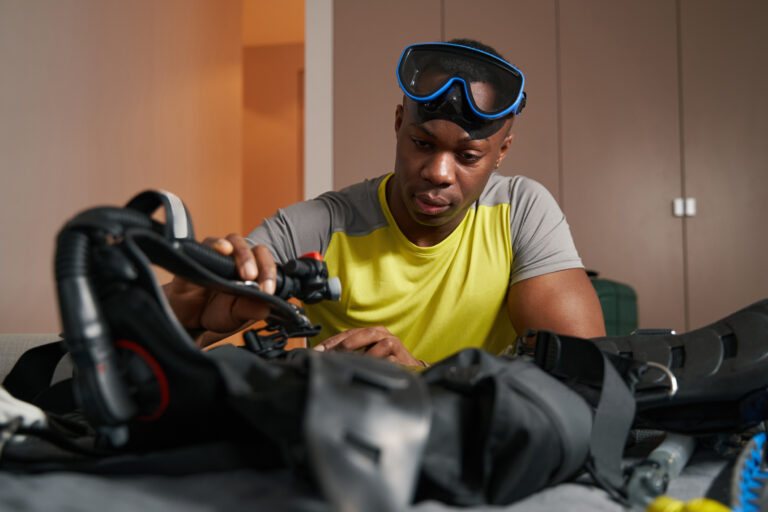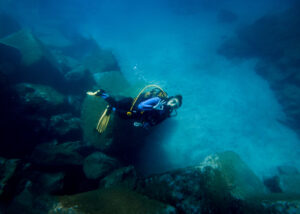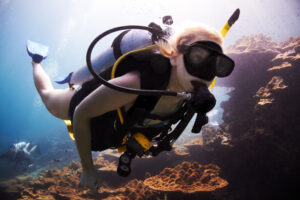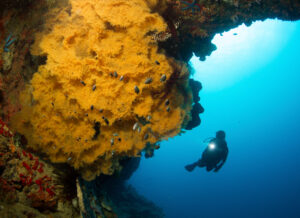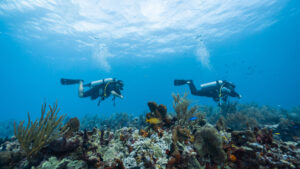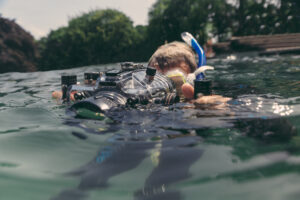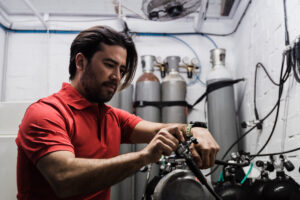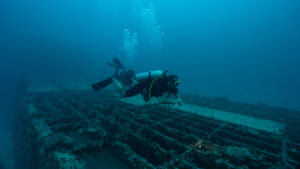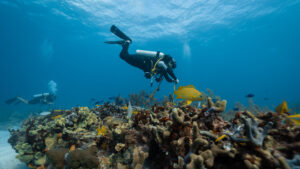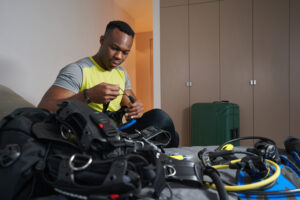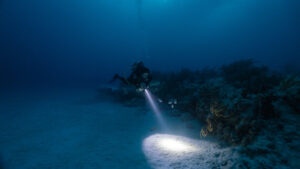What is a Submersible Pressure Gauge?
A submersible pressure gauge (SPG) is a vital piece of equipment for scuba divers, used to monitor the pressure of the air remaining in their diving tanks. This instrument is crucial for ensuring that divers have enough air to safely return to the surface. The SPG is typically connected to the diver’s first-stage regulator and displays the pressure in the tank in real-time, allowing divers to keep track of their air supply and manage their dive plans accordingly. By providing accurate and immediate feedback, the SPG helps prevent potentially dangerous situations caused by running out of air underwater.
History and Development
The submersible pressure gauge has a rich history rooted in the early days of scuba diving. Initially, divers relied on rudimentary methods to estimate their air supply, often resulting in unsafe conditions. The introduction of the first SPG in the mid-20th century marked a significant advancement in diving safety. Early models were simple, mechanical devices that provided basic pressure readings. These gauges revolutionized diving by offering a reliable way to monitor air supply, significantly reducing the risk of underwater emergencies.
Over the decades, the technology behind SPGs has evolved significantly. In the 1960s and 1970s, advancements in materials and engineering led to more durable and accurate gauges. Innovations such as the Bourdon tube mechanism, which measures pressure changes by flexing a coiled tube, improved the precision and reliability of SPGs. This period also saw the introduction of more compact and user-friendly designs, making SPGs more accessible to recreational divers.
Notable brands and inventors have played crucial roles in the development of SPGs. Companies like Aqua Lung, Scubapro, and Mares have been at the forefront of innovation, constantly improving the design and functionality of these instruments. Inventors and engineers dedicated to diving safety have contributed to the refinement of SPG technology, ensuring that modern gauges are both robust and highly accurate. Today, SPGs are standard equipment for divers worldwide, reflecting the continuous improvements made over the years.
Design and Functionality
The design and functionality of submersible pressure gauges are essential to their role in diving safety. An SPG typically consists of several key components: the gauge face, the protective case, and the connection to the tank. The gauge face displays the pressure reading, usually in both bar and psi, making it accessible to divers using different measurement systems. The protective case, often made of durable materials like stainless steel or high-strength plastic, shields the delicate internal mechanisms from damage.
The core functionality of an SPG is based on mechanical principles. Most SPGs use a Bourdon tube, a curved, flexible tube that straightens as pressure increases. This movement is translated into a needle movement on the gauge face, providing a visual indication of the tank pressure. This mechanical design ensures that SPGs are reliable and accurate under various diving conditions. Some modern SPGs incorporate additional features, such as luminescent dials for better visibility in low-light environments or high-contrast markings for easier reading.
Variations in SPG design cater to different diving environments and conditions. For instance, deep-sea divers require gauges that can withstand higher pressures and provide precise readings at greater depths. Cold-water divers benefit from SPGs designed to resist freezing and maintain accuracy in low temperatures. These variations ensure that divers can select an SPG that best suits their specific needs, enhancing their safety and confidence underwater.
Types of Submersible Pressure Gauges
Submersible pressure gauges come in various types, each with unique features and benefits. The most common distinction is between analog and digital gauges. Analog SPGs, which have been the standard for many years, use a mechanical needle to display pressure readings. These gauges are known for their simplicity, durability, and ease of use. Divers appreciate the straightforward design of analog SPGs, which provides clear and immediate feedback on air supply.
Digital SPGs, on the other hand, offer advanced features and greater precision. These gauges use electronic sensors to measure pressure and display the readings on a digital screen. Digital SPGs can provide additional information, such as depth and temperature, and often include alarms to alert divers to critical pressure levels. While digital SPGs are generally more expensive than their analog counterparts, they offer enhanced functionality and ease of reading, especially in challenging diving conditions.
Another important classification is between console and standalone SPGs. Console SPGs are integrated into a larger console that may include other instruments like a depth gauge and a compass. This integration provides divers with a comprehensive overview of their diving parameters in one place. Standalone SPGs, however, are separate units that can be attached to the diver’s equipment independently. These gauges offer greater flexibility and can be used in combination with other instruments as needed.
Usage in Scuba Diving
The use of a submersible pressure gauge is integral to safe scuba diving practices. Divers rely on SPGs to continuously monitor the pressure of the air in their tanks, ensuring they have sufficient supply for the duration of their underwater activities. Before entering the water, divers check their SPGs to verify that their tanks are fully charged and functioning properly. Throughout the dive, frequent checks of the SPG are essential to track air consumption and manage remaining air reserves effectively.
Safety protocols involving SPGs are critical for preventing accidents. Divers are trained to regularly check their SPGs and communicate their air levels to their diving partners. This practice, known as air sharing, ensures that all members of a diving group are aware of each other’s air supply and can assist if someone runs low. In addition, divers are taught to follow the “rule of thirds” – using one-third of their air supply for the descent, one-third for the bottom time, and one-third for the ascent and safety stop – to ensure a safe return to the surface.
The SPG also plays a crucial role in dive planning and execution. By monitoring air consumption rates, divers can plan their dives to avoid running out of air. This includes calculating the maximum depth and duration of the dive based on air supply and individual consumption rates. Accurate air management, facilitated by the SPG, allows divers to enjoy their underwater experience while minimizing the risk of emergencies.
Maintenance and Care
Proper maintenance and care of submersible pressure gauges are essential to ensure their reliability and longevity. Routine maintenance tasks include rinsing the SPG with fresh water after each dive to remove salt and debris, which can cause corrosion and affect the gauge’s accuracy. Divers should also inspect the SPG regularly for signs of wear, such as cracks in the protective case or damage to the hose and connections.
Common issues with SPGs can arise from both mechanical and environmental factors. Mechanical issues, such as a stuck needle or inaccurate readings, often result from internal component wear or damage. Environmental factors, such as exposure to extreme temperatures or impacts, can also affect the gauge’s performance. Troubleshooting these issues typically involves professional inspection and repair to ensure the SPG remains safe and accurate.
To maximize the reliability and lifespan of an SPG, divers should follow several best practices. These include avoiding exposure to direct sunlight for extended periods, storing the SPG in a cool, dry place, and protecting it from impacts during transport. Regular professional servicing, including calibration and pressure testing, helps maintain the gauge’s accuracy and functionality. By adhering to these maintenance guidelines, divers can ensure their SPG remains a dependable tool for safe diving.
Innovations and Future Trends
The field of submersible pressure gauges continues to evolve with advancements in technology and design. Recent improvements focus on enhancing the accuracy, durability, and user experience of SPGs. For example, new materials and manufacturing techniques have led to more robust gauges that can withstand higher pressures and harsh diving conditions. Innovations in sensor technology have also improved the precision of digital SPGs, providing divers with more reliable data.
Emerging trends in SPG technology include the development of wireless pressure transmitters. These devices transmit tank pressure information wirelessly to a wrist-mounted dive computer, eliminating the need for a physical gauge and hose. This innovation offers greater convenience and flexibility for divers, allowing them to monitor their air supply more easily. Wireless SPGs are gaining popularity among tech-savvy divers and those seeking a streamlined diving setup.
Looking ahead, the future of SPG technology is likely to see further integration with advanced dive computers and other underwater instruments. Enhanced connectivity and data-sharing capabilities will provide divers with comprehensive real-time information, improving safety and dive management. Additionally, advancements in battery technology and energy efficiency will make digital and wireless SPGs more practical for extended use. As these trends continue, SPGs will remain an indispensable part of scuba diving equipment, reflecting ongoing progress in diving safety and technology.
Key Takeaways
The submersible pressure gauge is an essential tool for scuba divers, providing critical information about air supply and enhancing underwater safety. From its historical development to its modern advancements, the SPG has evolved into a reliable and indispensable device. Understanding its design, types, and proper usage, along with maintaining it correctly, ensures divers can confidently manage their dives. Innovations and future trends promise even greater accuracy and convenience, reinforcing the SPG’s vital role in the diving community.

